Deep Interpretation | What challenges will the fashion industry face in 2024?
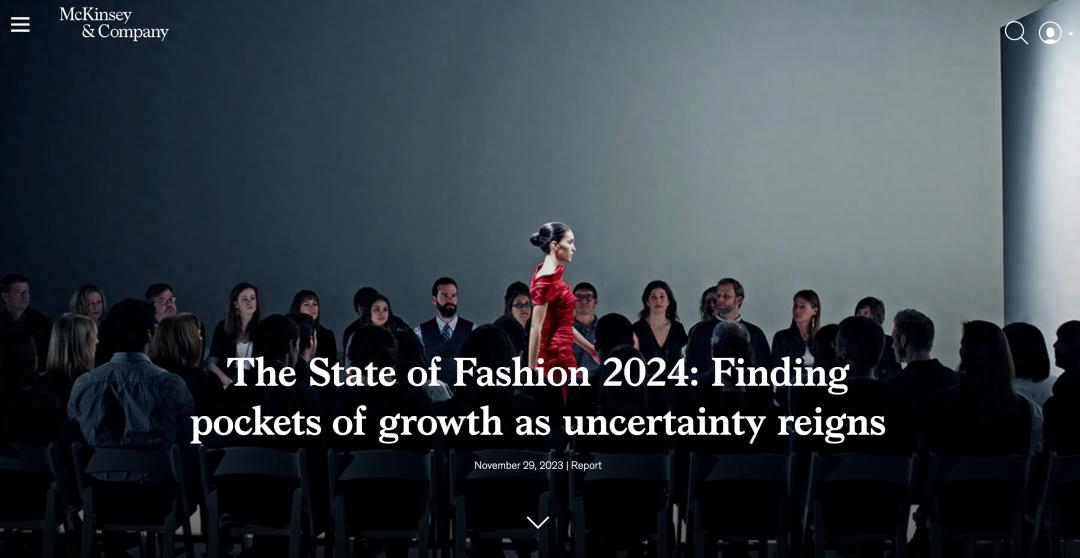
The State of Fashion 2024 Report
A few days ago, McKinsey and BOF jointly released the report "The State of Fashion 2024", which deeply discussed the current situation and future trend of the global fashion industry. The report covers consumer behavior, brand strategy, digital transformation and sustainable development. Let’s take stock of the potential challenges and opportunities that the fashion industry will face in 2024 through the interpretation of the report.
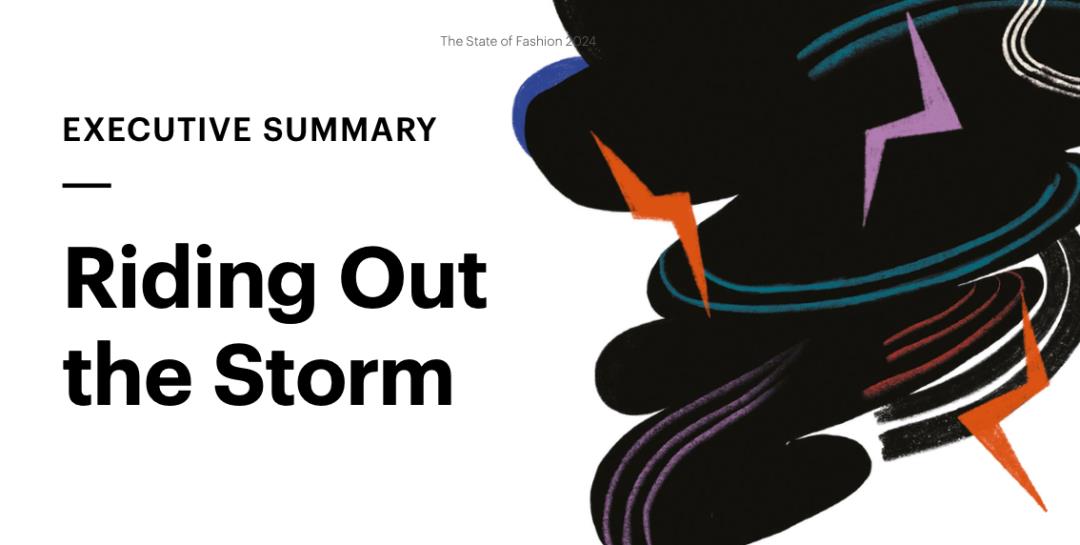
The State of Fashion 2024 Report
In 2024, fashion companies will face economic headwinds, technological changes and changing competition patterns. However, changes in consumers’ focus will continue to bring opportunities.
—— Introduction to the report
According to the report of The State of Fashion 2024,In the coming year, challenges such as weak economic growth, persistent inflation and weak consumer confidence may make industry leaders feel a lot of uncertainty. In this context, it will be a new challenge for enterprises to discover the value depression and release the new motivation of performance.
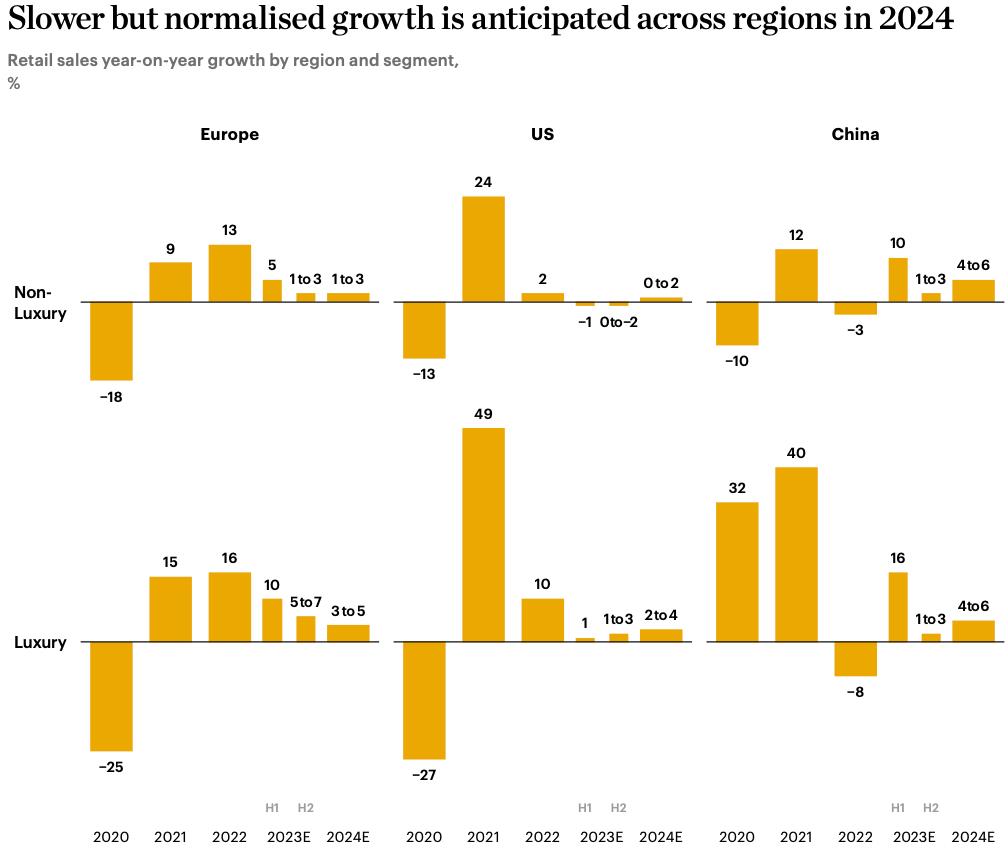
Source: McKinsey fashion status forecast; Mckinsey global fashion index (note: growth forecast reflects inflation)
We can see:It is predicted that the growth of all regions will slow down but tend to be normal in 2024, among which the growth of non-luxury goods and luxury goods market in China will be higher than that in the United States and Europe in the same period.
McKinsey also predicted that:In 2024, the retail sales of the global fashion industry will achieve a year-on-year growth of 2%-4% (there will be slight differences between different countries and regions). The luxury goods market will once again create the largest share of economic profits. It is estimated that the growth rate of global retail sales of luxury goods will slow down from 5%-7% in 2023 to 3%-5% in 2024, because consumers will curb consumption after experiencing the shopping boom after the pandemic.
10
Trend Prospect of Fashion Industry in 2024
# Global economy #
01 fragmented future
"In 2024, the global economic outlook may continue to be turbulent, and consumer spending may decrease in the coming year," the report wrote.Challenges from finance, geopolitics and other aspects will affect the confidence of global consumers, which requires suppliers, brands and retailers to strengthen emergency response measures.
The economic outlook report released by the Organization for Economic Cooperation and Development (OECD) on November 29th also shows that:The global GDP growth rate will slow down from 2.9% in 2023 to 2.7% in 2024, and it is estimated that the GDP growth will improve slightly in 2025, reaching 3%.It is predicted that from 2024 to 2025, Asia will continue to contribute most of the global economic growth as it did in 2023.
It is worth mentioning that "Emerging Asia", as a promising market, will provide potential growth points.
The urgency of climate
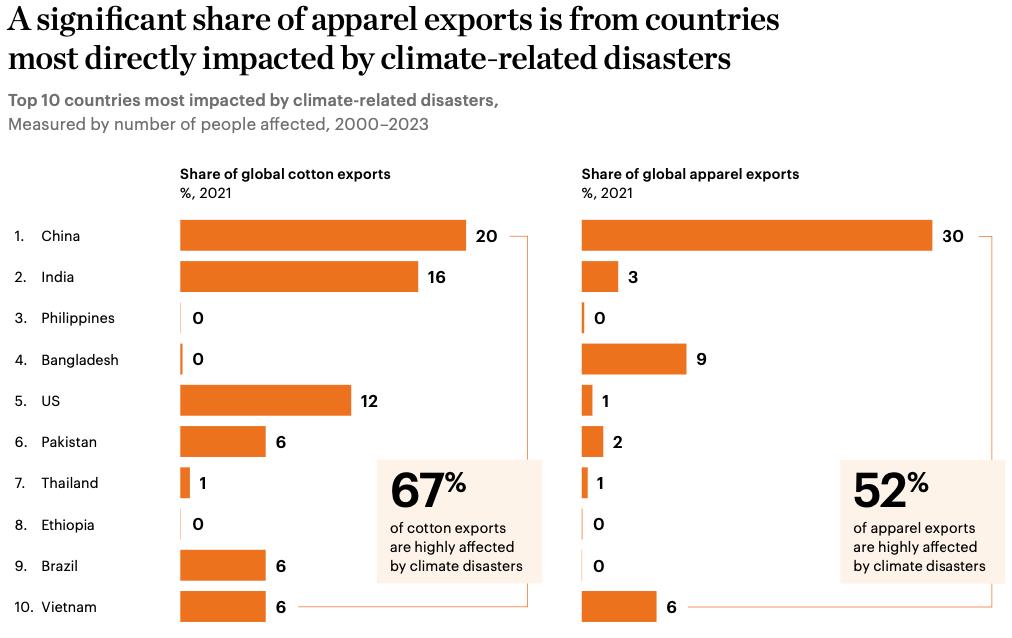
10 countries most affected by climate disasters (a large part of clothing exports come from the above countries) Source: United Nations Office for Disaster Risk Reduction, WTO.
In the past year, the frequency and intensity of extreme weather have proved that the climate crisis is continuing to intensify. These crises also make the fashion industry more fragile. According to the report, by 2030, extreme weather events may endanger the clothing export business worth $65 billion and make nearly 1 million jobs disappear in the four most important economies of the global fashion industry.
According to a report by Fashion Without Borders, 2024 may be the first year when the global average surface temperature is 1.5°C higher than that in the pre-industrial era. This is the first time that the British National Weather Service has predicted that the temperature may temporarily exceed 1.5°C within one year.As the climate crisis worsens, we in the fashion industry can’t delay any longer. We need to build resilience in the fashion supply chain and help reduce emissions.
# Consumer transfer #
03 vacation mode
Consumers are preparing for the largest tourism year since the outbreak of the pandemic. It is estimated that the number of global tourists will exceed the pre-pandemic level for the first time in 2024, reaching 110% of the 2019 level.
For travelers, shopping is still their "top priority". The data shows that 80% of consumers surveyed from the United States, Britain and China said they would buy fashion products when traveling in 2024, and 28% of them plan to spend more than the previous year; More than half of the respondents said they were looking for destinations they had never been to, including second-tier cities.Faced with such demand and changes in market trends, brands and retailers should consider updating their distribution and category strategies to meet the needs of travelers anytime and anywhere.
The new face of influence
The report also mentioned that compared with previous years, 68% of consumers began to be troubled by a large number of sponsored content on social media, and 65% of consumers reduced their dependence on fashion influencers.Consumers are more looking forward to the demand for authenticity, entertainment and approachable personality. The creators of "New Wave" were also born.-they advocate less exquisite aesthetics, grotesque, humor, and fragility.
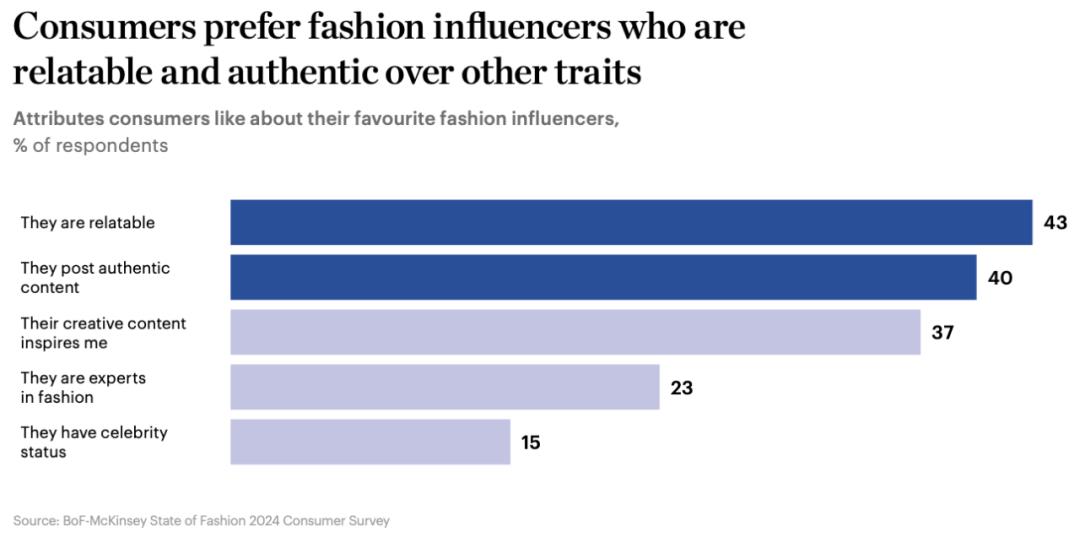
Consumers prefer fashion influencers with affinity and authenticity. Source: BoF-McKinsey 2024 Consumer Survey on Fashion Status.
In order to capture and retain the attention of online consumers in 2024, fashion marketers may break the tried-and-true routine and explore new ways to cooperate with creators.
05 outdoor sports re-innovation
Consumers’ pursuit of healthy lifestyle and "Gorpcore style" has promoted the development of technical outdoor clothing, and this trend may be further accelerated.More and more outdoor brands may launch lifestyle series, and lifestyle brands will integrate technical elements into the series, further blurring the boundary between functionality and fashion.
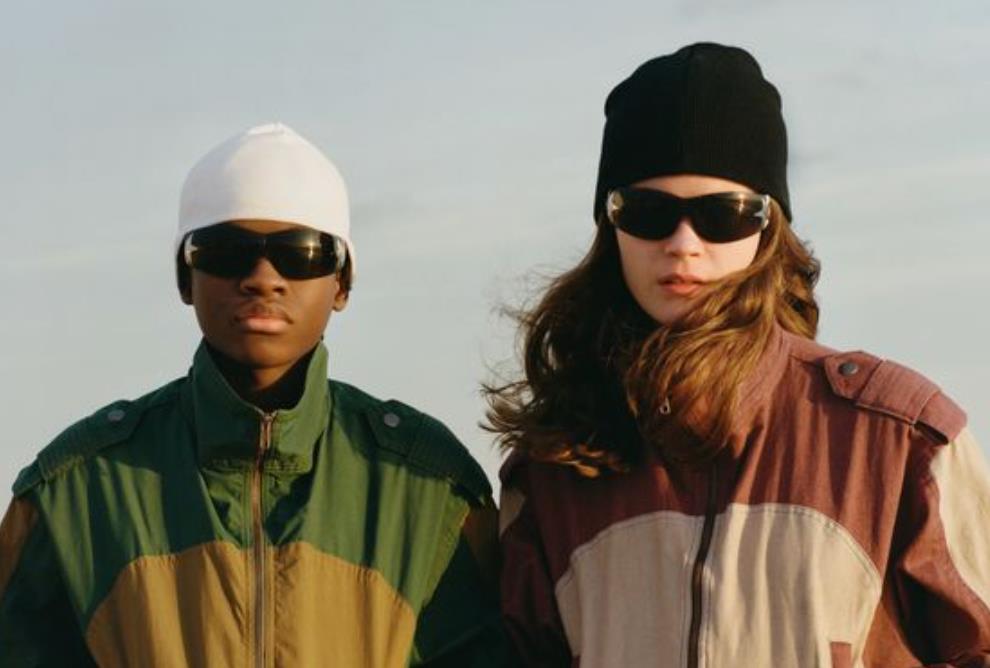
"Gorpcore" is abbreviated as "Good Ol’ Raisins and Peanuts", which describes the fashion style that combines street clothes with outdoor sports elements.
In recent years, outdoor clothing and shoes have been repositioned as daily items, which means thatThe brand will establish a closer relationship between style and practicality.. With the cooling of the "Gorpcore" trend,Brands may begin to tend to be low-key, "quiet outdoor" fashion.. The report also predicts that in 2024,Competition at different price points and categories may be intensified.Some outdoor brands will tilt their clothes to the high end, while others will adjust their footwear products.
# Fashion System #
06 new generation artificial intelligence
After the emergence of generative artificial intelligence in 2023, there have been some use cases in creative industries including fashion. In 2023, the equity financing of start-ups focusing on generative artificial intelligence surged, reaching $14.1 billion in the first half of this year alone.To seize the value of this revolutionary technology in 2024, the fashion industry needs to go beyond automation and explore its potential to enhance the work of human creative personnel.At present, the EU has reached a preliminary agreement on the artificial intelligence bill, which has reached three points of consensus, including clarifying the obligations of AI systems classified as high-risk, and proposing that citizens should have the right to lodge complaints and have the right to obtain meaningful explanations; The general AI system and model must be transparent, and the biometric identification system should be used in public places for law enforcement purposes, thus achieving exceptions and safeguards for law enforcement exemption.
As mentioned in the report, as many as a quarter of the potential value of generative artificial intelligence in fashion may be driven by use cases in design and product development. 73% of fashion executives have said that in 2024, generative artificial intelligence will become a priority for their enterprises, and 28% of enterprises have tried to use it in the creative process of design and product development.
07 fast fashion power game
In the coming year, the competition of fast fashion may be more intense. Challengers, led by Shein, a B2C fast fashion e-commerce platform, and Temu, a cross-border platform owned by Pinduoduo, are changing their strategies around price, customer experience and speed.

Temu
In the past 12 months, 40% American consumers and 26% British consumers have shopped in Shein or Temu. The success of these companies benefits from the innovation of operating models, including flexible design of supply chain from manufacturers to consumers and data-driven product design. These innovations make fashion faster and cheaper than before.
In 2024, this generation of fast fashion may face some challenges as the standards of regulators and consumers on topics such as sustainable development and trade practice are constantly changing.The success of disruptors and incumbents will depend on whether they can adapt to the changing consumer preferences and control the laws and regulations that may affect the industry.
08 Pay attention to the brand
The pattern facing the fashion industry is changing, and performance marketing is no longer the main focus.Brand marketing may become the focus of fashion again in the coming year. The emotional connection between consumers and brands is also likely to become the key for fashion marketers to adjust their strategies and emphasize long-term brand building strategies.According to the survey, 71% of fashion executives plan to invest more money in brand marketing in 2024 than before, and 46% plan to invest more money in effect marketing.
In view of the increasing cost of effect marketing and the restrictions on customer orientation by data privacy laws, fashion marketers need to find new ways to attract shoppers.In the future, brands may improve the way of establishing emotional connection with consumers through marketing, and may cooperate in fashion industry and adjacent fields to create fascinating brand stories.
09 sustainability rules
The era of self-restraint and sustainable development of fashion industry will end on a global scale. New rules from various jurisdictions may have a wide impact on consumers and the fashion industry. Brands and manufacturers need to reform their business models to adapt to future changes.
The report also mentioned that at the end of 2023, there were as many as 16 pieces of legislation related to fashion and textiles under discussion in the EU alone, and the first batch will take effect in 2024. Relevant laws and regulations will cover the whole fashion value chain from product design to marketing, which will have an impact on consumers and enterprises around the world.
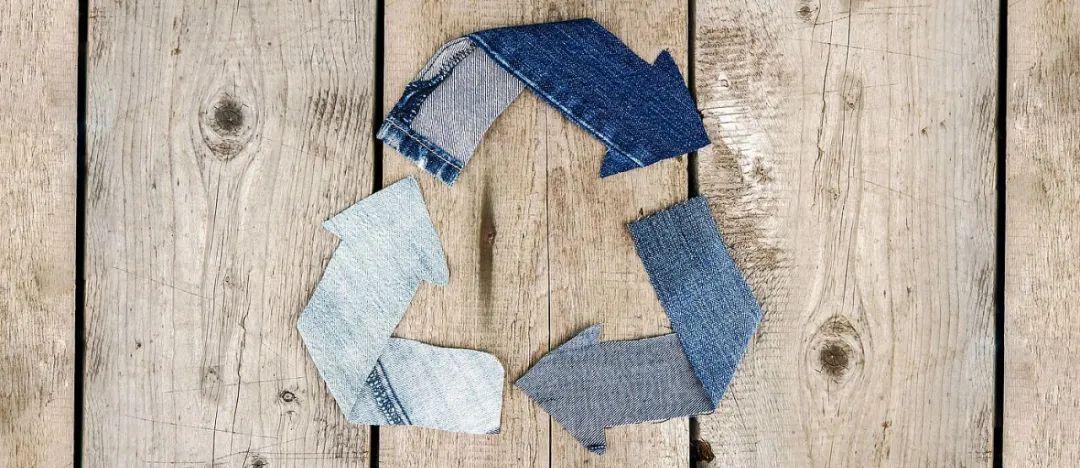
The latest EU textile regulations are expected to be promulgated in 2024, which are applicable to all companies engaged in textile trade in the EU.
10 whip effect
The change of consumer demand leads to the "Bullwhip effect", which brings pressure to fashion suppliers.The "bullwhip effect" refers to the phenomenon that when the demand information in the middle and lower reaches of the supply chain is transmitted to the upstream, retailers, distributors and wholesalers are overweight layer by layer because the information cannot be effectively shared, and the demand is getting higher and higher upstream, just like waving a bullwhip, which eventually leads to a great difference between the demand data obtained by the most original supplier and the demand information of customers in the actual consumer market.
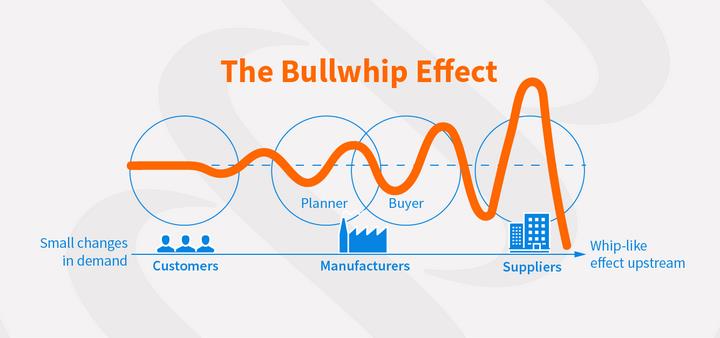
Bullwhip effect
In the fashion industry, the impact of demand fluctuation on upstream suppliers is particularly serious. According to the report data, the production capacity of factories that were produced at full capacity in 2021 has dropped by 30%-40% by 2023. According to 73% of chief procurement officers, this volatility will become one of the primary challenges affecting supplier relations in the next five years.If the supply wants to keep up with the expected new demand, brands and retailers should consider paying attention to transparency and strengthening strategic partnership.
*
The report of The State of Fashion 2024 writes:Looking forward to 2024, fashion leaders are expected to encounter more unfavorable factors and feel uncertain about the prospects for the coming year.. In the survey conducted in early September, 26% of the respondents expected the market situation to improve in 2024, 37% expected the situation to remain unchanged, and 38% expected the situation to deteriorate. This is the biggest difference in the BoF-McKinsey survey since 2017.
It is not difficult to predict that the next year will still be a year of crisis and opportunity. Although it is full of changes, there is still a breakthrough prospect.Facing the innovation of science and technology and the development of artificial intelligence, enterprises can seize opportunities by making full use of technology; Faced with the increasing demand of consumers for authenticity and affinity of content, marketers can consider taking advantage of the new wave of creation to create a new brand narrative; In the year when people rekindle their enthusiasm for travel, enterprises can further enhance the way of interacting with consumers and create a brand experience that breaks through the tradition …
All in all, 2024 is a challenging year. We are full of confidence, but we are not blindly optimistic. We also expect industry practitioners to ride the wind and waves, rebuild their confidence in the process of recovery, lay a solid foundation and accumulate wealth.
For more details, please pay attention to WeChat WeChat official account: Fashion Without Borders.